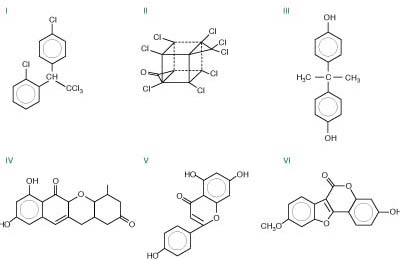Endocrine disruption by estrogenic environmental pollutants
by B. Rey de Castro
http://www.envimed.com/emb13.shtml
|
Structures of estrogenic compounds. The pesticides o,p'-DDT (I) and chlordecone (II; Kepone); the plasticizer bisphenol-A (III); and the phytoestrogens zearalenone (IV), genistein (V), and coumestrol (VI). |
.
Overview
Over the last twenty years, there has been a steadily growing awareness that a wide variety of hormonally active environmental pollutants may exert adverse physiologic effects by disrupting normal endocrine function. Among the health effects thought to be associated with environmental endocrine disruption are disordered fetal development, impaired reproductive capability and behavior, and excessive cell proliferation promoting carcinogenesis. Neurologic and immunologic effects have also been implicated. The hypothesis of environmental endocrine disruption may be stated in the following manner:
"Environmental pollutants that bind to hormone receptors are able to induce inappropriate or disproportionate endocrine system responses, thereby causing adverse disruption of normal physiologic function."
There are two main sources of evidence favoring this hypothesis. The first is extensive experimental evidence showing that many xenobiotic compounds have intrinsic hormonal activity. Laboratory animal studies indicate that a wide variety of hormone-dependent physiologic effects are associated with exposure to environmental pollutants, and in vitro mechanistic studies have demonstrated that environmental pollutants not only have affinity for hormone receptors but are also able to act via the receptor to induce agonistic or antagonistic effects. The second body of evidence favoring the endocrine disruption hypothesis derives from incidents of acute human and wildlife exposure to hormonally active xenobiotics, which have typically resulted in impaired reproductive capability in the exposed individuals and in their offspring, although cancer has also been implicated. Apparent trends in human disorders related to hormonal disruption, such as decreased sperm counts and increased incidence of breast and testicular cancers, are consistent with a possible role for widespread endocrine disruption, although this association remains controversial.
As compelling as this evidence is, the notion of environmental endocrine disruption must also be considered in light of other significant facts. For example, although many environmental pollutants have been shown to have intrinsic hormonal activity, their potencies are typically several orders of magnitude less than the endogenous hormone, which may obviate significant physiologic effects for all but the highest exposures.
...
Dr. de Castro is a Research Associate in the Department of Environmental Health at the Harvard School of Public Health, Boston, Massachusetts, USA, where he completed his doctoral thesis research on exposure to estrogenic pollutants, particularly polychlorinated biphenyls and urban airborne particulate matter.
